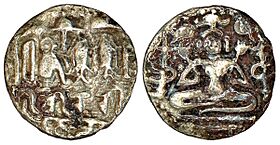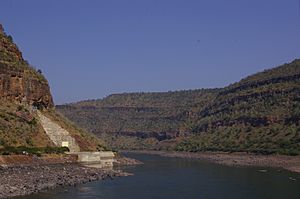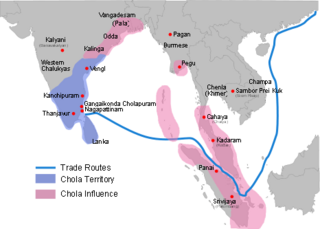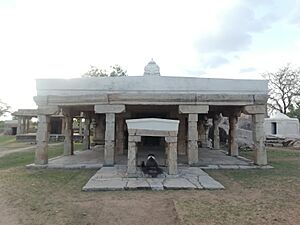Virarajendra facts for kids
Quick facts for kids Virarajendra Chola |
|
|---|---|
| Rajakesarivarman, Karikala Chola, Maharajadhiraja, Pandya Kulantaka, Konerinmaikondan, Srimedinivallabha, Ahavamalla Kula Kaalan, Sakalabhuvanasraya | |

Gold Kahavanu of Virarajendra
11th century |
|
| Chola Emperor | |
| Reign | 1065–1070 |
| Predecessor | Rajendra II |
| Successor | Athirajendra |
| King of Kadaram | |
| Reign | 1067–1070 |
| Predecessor | position established |
| Successor | Athirajendra |
| Born | 1002 Thanjavur, Chola Empire (modern day Thanjavur, Tamil Nadu, India) |
| Died | 1070 (aged 68) Gangaikonda Cholapuram, Chola Empire (modern day Jayankondam, Tamil Nadu, India) |
| Queen | Arulmolinangai |
| Issue | Athirajendra Gangai kondan Rajasundari |
| Dynasty | Chola |
| Father | Rajendra I |
| Mother | Mukkokilan Adigal |
| Religion | Hinduism |
Virarajendra Chola (born 1002, died 1070) was a powerful emperor of the Chola Empire. He was the son of Rajendra I. For much of his life, he served under his older brothers, Rajadhiraja I and Rajendra II.
During his rule, Virarajendra Chola did many good things for his people. He helped set up a school to study ancient texts like the Vedas and Sastras. This school even had a place for students to live. He also built a hospital called Virasolan to care for sick people. A famous book on Tamil grammar, Virasoliyam, was written during his time.
Virarajendra became king when the Chola Empire was facing challenges. His older brothers had ruled for a short time, and enemies saw this as a chance to rebel. But Virarajendra was a brave and kind ruler. He protected his people and made sure the Chola Empire stayed strong. He even made conquests in faraway lands like Indonesia, Malaysia, Sri Lanka, and Nicobar.
Contents
Early Life of Virarajendra Chola
Virarajendra Chola had important roles even before he became emperor. His older brother, Rajadhiraja Chola, made him the leader of Sri Lanka (then called Singhala Nadu). Later, under his other brother Rajendra Chola II, he was in charge of Uraiyur.
Virarajendra's Military Victories
Virarajendra Chola fought many battles to protect and expand the Chola Empire. A big reason for these wars was the Cholas' interest in the Vengi Chalukyas. He defeated the Western Chalukyas near modern Vijayawada, making sure the Cholas controlled the Eastern Chalukya lands. He also stopped the kings of Sri Lanka from breaking free from Chola rule.
Early Battles and Rebellions
Early in his reign, Virarajendra fought and defeated the kings of Pottapi and Kerala. He also had to put down a rebellion by princes in the Pandya region. While he was busy with these battles, the Western Chalukya king, Someshvara I, tried to invade the Chola country.
Someshvara I sent his son, Vikramaditya VI, to attack Gangaikonda Cholapuram, the Chola capital. But Virarajendra was returning after his victories in Pandya, Sri Lanka, and Kerala. He quickly protected his capital and drove Vikramaditya VI away.
Next, Virarajendra chased the Chalukya princes, Vikramaditya and Singhanan, and completely defeated their army. He then went to the Chalukyan capital and defeated Someshvara I, who fled the battle. Virarajendra fought the Chalukyas a third time when Someshvara I tried to take over Vengi. Virarajendra's armies won again, surrounded the Chalukyan capital, and took valuable treasures.
Virarajendra successfully stopped all rebellions in Sri Lanka, Madurai, Kerala, and Potappi. He also made the Western Chalukyas pay tribute to the Chola Empire.
Continuing Wars with the Chalukyas

Virarajendra’s rule is known for his many victories against the Western Chalukyas. He had fought them even before he became king. Someshvara I, who had lost battles before, wanted to get revenge.
Virarajendra proudly stated in his inscriptions that Someshvara I's sons, Vikramaditya VI and Jayasimha III, ran away from the battlefield. Virarajendra claimed he defeated Someshvara I's armies at least five times. These battles happened in places like Kudalasangamam, Gangaikondacholapuram, Karur, Kampili, and Vengi. Each time, Someshvara I's generals were defeated, and his sons fled.
Someshvara I then challenged Virarajendra to a final battle at Kudal Sangamam. Virarajendra arrived with his army and waited for over a month, but Someshvara I never showed up. The Chola army then destroyed the nearby lands and put up a victory pillar by the Tungabhadra River.
It's believed that Someshvara I couldn't fight because of problems within his own family. His sons, Someshvara II and Vikramaditya VI, were fighting over who would be king. Vikramaditya VI even allied with Virarajendra. Virarajendra recognized Vikramaditya VI as the next Chalukya king and gave him his daughter in marriage. This alliance helped end the long conflict between the two empires.
After this, Someshvara I took his own life in March 1068 C.E.
From Kudal Sangamam, the Chola army went to Vengi to regain control of the Eastern Chalukyan Kingdom. Virarajendra defeated the Western Chalukya army near the Krishna River. He then conquered the entire Eastern Chalukya kingdom and defeated the king of Kalinga, who had sided with the Western Chalukyas. Virarajendra placed Vijayaditya, an Eastern Chalukya prince, on the Vengi throne.
War in Sri Lanka
Vijayabahu, the king of Sri Lanka, wanted to drive out the Chola forces. He ruled a small part of the island and tried to expand his power. Virarajendra sent his army to attack Vijayabahu's area. Vijayabahu asked for help from the king of Burma, who sent ships and soldiers. With this help, Vijayabahu started revolts in the northern parts of Sri Lanka. Even though the Chola army managed to control these revolts, Vijayabahu continued to cause trouble for several years.
Kadaram Campaign
In 1068 C.E., Virarajendra's records show that he conquered Kadaram (part of modern-day Malaysia) to help a king who asked for his protection. He then gave the kingdom back to that king. We don't have many details about this naval campaign or the king who asked for help.
The Cholas continued to raid and conquer areas in what is now Indonesia and Malaysia for about 20 more years. This helped the Chola kingdom keep its strong influence in the Far East. It also made sure that traders from Chola lands could travel freely. Trade between Tamilakam (southern India) and the Far East continued without problems for a long time, even after some kingdoms became independent.
Virarajendra's Alliance and Personal Life

After Someshvara I died, his son Someshvara II became the Chalukyan king. But soon, a fight broke out between Someshvara II and his younger brother, Vikramaditya. Vikramaditya fled to Virarajendra Chola's court. Virarajendra welcomed him and recognized him as the rightful king of the Western Chalukyas. To make their alliance stronger, Virarajendra married his daughter to Vikramaditya VI. This helped stop the long-standing conflict between the two empires.
Virarajendra's queen was named Arumolinangai. His daughter, Rajasundari, married a prince from the Eastern Ganga Dynasty. Their son, Anantavarman Chodaganga Deva, became a famous king.
Virarajendra was a devoted follower of Lord Shiva at Chidambaram, to whom he gave a beautiful ruby necklace. Like the kings before him, he also supported temples of all faiths, including those dedicated to Lord Vishnu.
Death and Succession
Virarajendra Chola died in early 1070 C.E. after a short but very successful rule. He was not much younger than his brothers and was likely in his middle years when he became king. His reign was full of victories, both in managing the empire and in military conquests. His achievements are often compared to those of Rajendra Chola I, who greatly expanded the empire.
Virarajendra was followed by his son, Athirajendra Chola, who became the next emperor.




